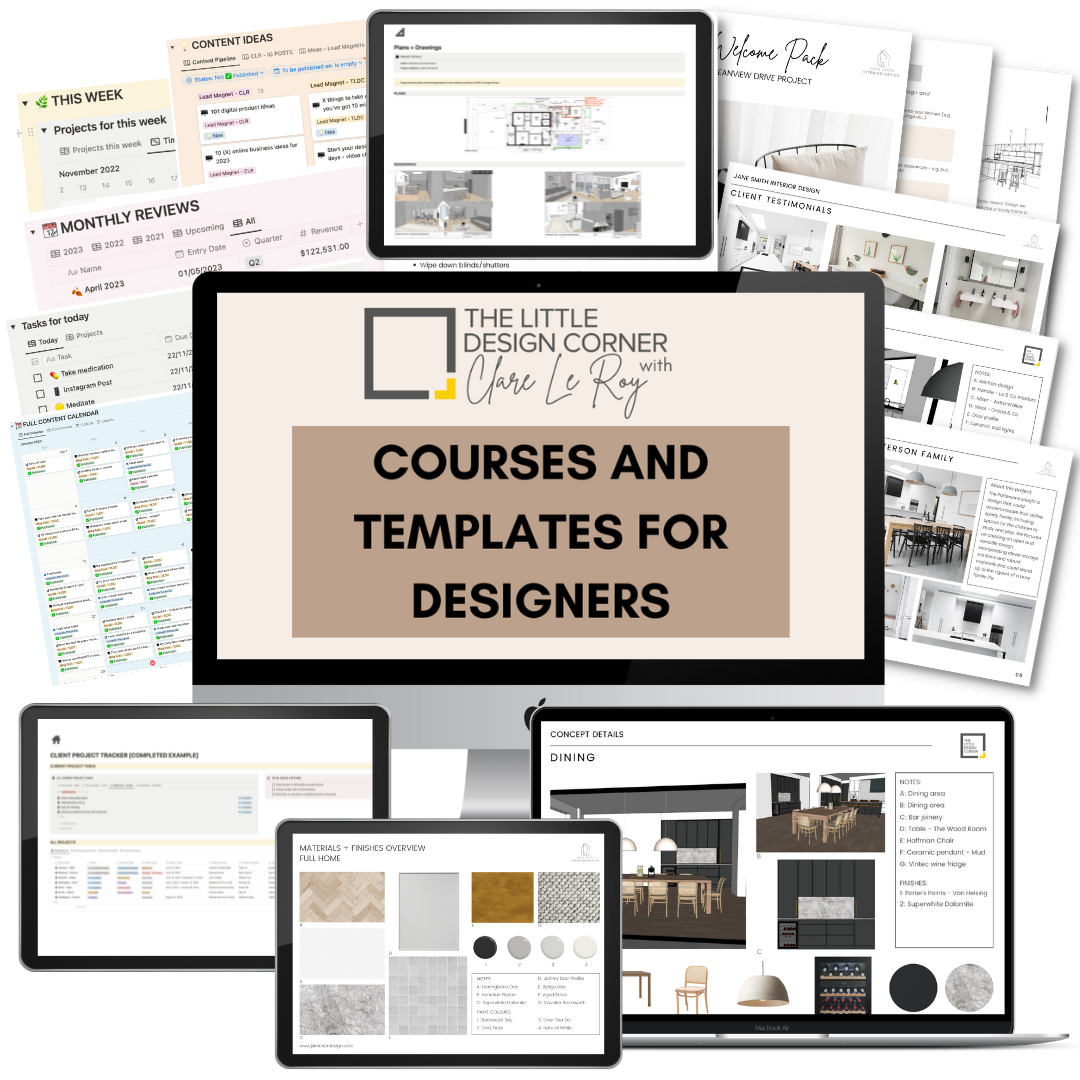Writing an interior design project scope of work: step by step instructions
One of the biggest challenges we face in interior design is managing client expectations and avoiding scope creep. The key to solving this is having a clear and detailed scope of work right from the start of a project.
In this post I walk you through a step by step guide on how to write a comprehensive scope of work for an interior design project.
Creating a comprehensive scope of work
Before getting started, let’s quickly talk about why a scope of works is so important.
A well crafted scope of works sets expectations, outlines every aspect of the project and acts as a roadmap from start to finish. It helps you manage a project efficiently, avoid misunderstandings and make sure that both you and your client are on the same page.
It’s also how you avoid the common (and dreaded) scope creep!
So let's break down the key components of a comprehensive scope of work for a typical residential design project. Each step is designed to cover all aspects of an interior design project, from initial concept to final installation.
You’ll most likely need to adjust it based on the specific needs of each project and client, but hopefully it gives you some idea of things to think about.
As we go through each step consider how it applies to your typical projects and where you might need to add or modify elements to suit your own design process.
The goal is to create a templated version of a scope of work that you can easily update and customise as each new project comes in. This will save you lots of time as you prepare your fee proposals (which is generally where your scope of work will first be presented).
1. Project Overview
Start with a brief overview of the project. This section should include:
Project Title: Give your project a specific and identifiable name. It’s a good idea to have a set style guide for how you do this in your business, so all projects are named in the same way
Client Information: Include the client’s name and contact details.
Project Location: Specify where the project is located.
Project Description: Provide a short description of what the project entails. For example, "Full renovation and styling of a 5 bedroom house."
2. Spaces Included
Clearly define the spaces/areas included in the project, list them all to avoid any confusion.
3. Discovery Phase
This phase is all about gathering information and understanding the client’s needs and the existing site conditions.
Kick Off Meeting:
Objectives: What do you need to learn from the client? Think about their needs, preferences, lifestyle and budget
Deliverables: Meeting notes and an initial client brief
Existing Conditions Survey:
Tasks: Conduct site visits, take measurements, photos and assess existing conditions
Deliverables: Existing conditions survey and as-built drawings
Client Research and Inspiration:
Tasks: Research client’s style preferences and gather inspiration images
Deliverables: Joint Pinterest board between client/designer
4. Concept Phase
In this phase you will develop and refine design concepts.
Concept Development:
Tasks: Develop initial design concepts including space planning, colour scheme and material palettes
Deliverables: Concept sketches, mood boards and preliminary floor plans. Meeting with client to present the initial concept(s)
Design Refinement:
Tasks: Refine the chosen design concept based on client feedback
Deliverables: Revised floor plans, drawings and material selections
Final Design Presentation:
Tasks: Present the final design to the client for approval
Deliverables: Final design concept, floor plans and 3D renderings
5. Documentation Phase
In this phase you create all the detailed drawings and specifications needed for the project.
Detailed Design Drawings:
Tasks: Create detailed design drawings, including final floor plans, elevations, sections and details
Deliverables: Complete set of detailed design drawings for all areas (living rooms, bedrooms, kitchen, bathrooms, etc.)
Specifications:
Tasks: Specify materials, finishes, fixtures, and furniture
Deliverables: Specification sheets and schedules for finishes, fixtures and furniture (get my templates HERE if you need them).
Approval and Sign Off:
Tasks: Obtain client approval for all design documents and specifications
Deliverables: Signed client approval
6. Construction Phase
This phase involves coordinating with contractors and overseeing the construction process.
Pre-Construction Coordination:
Tasks: Meet with contractors regarding questions around design intent
Deliverables: Pre-construction meeting minutes
Construction Progress Tracking + Design Advice:
Tasks: Conduct site visits, respond to contractor inquiries and ensure design intent is maintained
Deliverables: Site visit reports/updates
7. Installation Phase
In this phase you’ll oversee the delivery and installation of all elements to bring the design to life.
Delivery and Installation:
Tasks: Coordinate the delivery and installation of furniture, fixtures and equipment (FF&E)
Deliverables: Delivery schedule and FF&E checklist. All items installed and styled
8. Project Completion
Wrap up the project with final documentation and a smooth handover to the client.
Final Walkthrough:
Tasks: Conduct a final walkthrough with the client and create a defect list
Deliverables: Final walkthrough report and defect list
Client Handover:
Tasks: Provide the client with all final documents, warranties and maintenance instructions. The Client Handover Pack is good for this. Handover the completed project to the client.
Deliverables: Project close out binder (Handover Pack) with final drawings, specifications, warranties and maintenance guides.
Things to consider when preparing a scope of work
Clearly define the number of design revisions included in each phase
Specify the exact deliverables (e.g. types of 3D renderings, types of drawings you will be providing)
Define how many changes will be permitted to concepts
Outline the decision making process and timeline for client approvals
Define the extent of services during construction (generally designers will not be managing any trades or contractors - role during construction is to supervise design intent only)
Clarify responsibility for obtaining permits and approvals
Specify any exclusions and ‘out of scope’ work (e.g. structural changes, electrical or plumbing upgrades etc.).
Address potential additional services and their associated fees
Include info about how changes to the scope will be handled and billed
Define the process for client provided items or contractor provided services
Specify the handling of any existing furniture or other items the client wants to keep
An example scope of work - 5 bedroom home renovation
1: Project Overview
Project Name: Smith Residence
Client Information: John and Jane Smith
Project Location: 123 Maple Street, Anytown
Project Description: Full renovation and styling of a 5 bedroom, 3 bathroom family home including all joinery/cabinetry design and detailing plus the furnishing and styling of the home
Total area: 550 square metres
Timeline: 7 months from concept to completion
2: Spaces Included
2 x living rooms
Dining room
Kitchen and butler’s pantry
Master bedroom, WIR and ensuite
4 additional bedrooms
2 additional bathrooms
Home office
Laundry
Entry and hallways
3: Discovery Phase
Kick off meeting
Site visit and detailed measurements of all spaces
Photographic documentation of existing conditions
Review of architectural plans and structural limitations
Establish project budget
Create project timeline
Develop joint Pinterest board "123 Maple Street Inspiration"
Client Onboarding Questionnaire completed (get my template HERE if you need it)
4: Concept Phase
Develop initial design concept including colour schemes, space planning, selection of finishes and preliminary furniture/artwork/accessories selections
Create mood boards, 3D renderings and concept document
Present complete design package to client
Signed client approval of design concept
Up to 2 rounds of revisions
5: Documentation Phase
Create detailed construction documents
Prepare detailed cabinetry/joinery/millwork drawings
Prepare lighting and electrical plans
Develop specifications for all materials and finishes (FF&E schedule)
Create furniture and decor procurement list (furniture schedule)
Present full package to client
Signed client approval of final design package
Up to 2 rounds of revisions
6: Construction Phase
Assist in the vetting, selection and bid process with builders/trades (final decisions on this are made by client - not by us)
Regular site visits as needed (12 one hour meetings total)
Supervision of design intent and ongoing review, advice and decision making around design issues as they arise
Regular client updates (weekly email, site meetings up to 12 one hour meetings)
Additional site visits beyond those in scope will be charged at our hourly rate of $150/hour
7: Installation Phase
Order all specified furniture, accessories and materials (per FF&E and Furniture Schedules)
Track all orders and shipments
Coordinate deliveries with construction timeline
Quality control checks upon delivery
Oversight of furniture/accessories installation
Hang artwork and mirrors
Wash new linen and make beds
Arrange and order accessories and styling elements
Organise pantry and storage spaces
Final styling of all rooms
8: Project Completion
Final walkthrough with client
Create defect list (relating to design elements) and coordinate with trades
Collect and organise all product warranties and care instructions into Close Out Binder (Handover Folder)
Prepare a home maintenance guide
Professional photography of completed project (1 day) - final images provided to client as part of our services
Final client presentation and project handover
Additional Notes/Out of Scope:
Structural changes or engineering services
Obtaining permits or approvals (responsibility of the builder/general contractor)
Electrical or plumbing system upgrades beyond cosmetic changes
Asbestos or lead paint testing/removal
Design of any exterior work, landscaping or pool area
Purchase and/or installation of large appliances (e.g. fridge, ovens, washers/dryers)
Installation of security systems including cameras, alarms or monitoring services
Design or modification of built in electronics (e.g. home theatre)
Window treatments beyond decorative (e.g. no structural blinds or shutters)
Audio/visual or smart home system design and installation
Valuable art installation (e.g. of your existing collection)
Relocation or storage of existing furniture and belongings
Deep cleaning or post construction cleaning services
Responsibility for ongoing maintenance or repairs after the final walkthrough
Please note that any work outside of the scope listed above will be charged at our hourly rate of $150/hour
By following these steps, you’ll be able to create a robust scope of work that sets clear expectations and reduces the risk of scope creep.
Thanks for reading and catch you in my next post :)
Clare x
Dr Clare Le Roy
Courses and Templates for Designers and Architects
DO YOU WANT TO….
Improve your professionalism?
Find more clients?
Bring in more revenue?
Create better systems and processes?
Then check out my business courses and templates for designers and architects.
These courses and templates leave you with work done - not just a long list of things you need to do next. We have a really strong focus on taking action and getting things created that improve your business.








